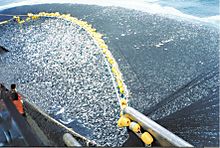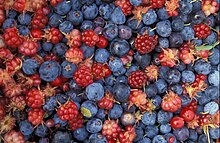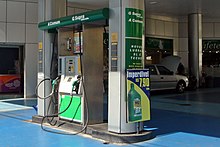Renewable resource



A renewable resource (also known as a flow resource
Definitions of renewable resources may also include agricultural production, as in agricultural products and to an extent water resources.[2] In 1962, Paul Alfred Weiss defined renewable resources as: "The total range of living organisms providing man with life, fibres, etc...".[3] Another type of renewable resources is renewable energy resources. Common sources of renewable energy include solar, geothermal and wind power, which are all categorized as renewable resources. Fresh water is an example of a renewable resource.
Air, food and water
Water resources
Water can be considered a renewable material when carefully controlled usage and temperature, treatment, and release are followed. If not, it would become a non-renewable resource at that location. For example, as groundwater is usually removed from an aquifer at a rate much greater than its very slow natural recharge, it is a considered non-renewable resource. Removal of water from the pore spaces in aquifers may cause permanent compaction (subsidence) that cannot be renewed. 97.5% of the water on the Earth is salt water, and 3% is fresh water; slightly over two thirds of this is frozen in glaciers and polar ice caps.[4] The remaining unfrozen freshwater is found mainly as groundwater, with only a small fraction (0.008%) present above ground or in the air.[5]
Water pollution is one of the main concerns regarding water resources. It is estimated that 22% of worldwide water is used in industry.[6] Major industrial users include hydroelectric dams, thermoelectric power plants (which use water for cooling), ore and oil refineries (which use water in chemical processes) and manufacturing plants (which use water as a solvent),it is also used for dumping garbage.
Desalination of seawater is considered a renewable source of water, although reducing its dependence on fossil fuel energy is needed for it to be fully renewable.[7]
-
Panorama of a natural wetland (Sinclair Wetlands, New Zealand)
Non agricultural food

Food is any substance consumed to provide nutritional support for the body.[8] Most food has its origin in renewable resources. Food is obtained directly from plants and animals.
Hunting may not be the first source of meat in the modernised world, but it is still an important and essential source for many rural and remote groups. It is also the sole source of feeding for wild carnivores.[9]
Sustainable agriculture
The phrase sustainable agriculture was coined by Australian agricultural scientist Gordon McClymont.[10] It has been defined as "an integrated system of plant and animal production practices having a site-specific application that will last over the long term".[11] Expansion of agricultural land reduces biodiversity and contributes to deforestation. The Food and Agriculture Organization of the United Nations estimates that in coming decades, cropland will continue to be lost to industrial and urban development, along with reclamation of wetlands, and conversion of forest to cultivation, resulting in the loss of biodiversity and increased soil erosion.[12]

Although
Agricultural practices are one of the single greatest contributor to the global increase in soil erosion rates.[13] It is estimated that "more than a thousand million tonnes of southern Africa's soil are eroded every year. Experts predict that crop yields will be halved within thirty to fifty years if erosion continues at present rates."[14] The Dust Bowl phenomenon in the 1930s was caused by severe drought combined with farming methods that did not include crop rotation, fallow fields, cover crops, soil terracing and wind-breaking trees to prevent wind erosion.[15]
The
The phenomenon called peak soil describes how large-scale factory farming techniques are affecting humanity's ability to grow food in the future.[18] Without efforts to improve soil management practices, the availability of arable soil may become increasingly problematic.[19][unreliable source?]
Methods to combat erosion include no-till farming, using a keyline design, growing wind breaks to hold the soil, and widespread use of compost. Fertilizers and pesticides can also have an effect of soil erosion,[20] which can contribute to soil salinity and prevent other species from growing. Phosphate is a primary component in the chemical fertiliser applied most commonly in modern agricultural production. However, scientists estimate that rock phosphate reserves will be depleted in 50–100 years and that Peak Phosphate will occur in about 2030.[21]
Air
Air is a renewable resource. All
Non-food resources

An important renewable resource is wood provided by means of forestry, which has been used for construction, housing and firewood since ancient times. .
With regard to pharmacy ingredients and legal and illegal drugs, plants are important sources, however e.g. venom of snakes, frogs and insects has been a valuable renewable source of pharmacological ingredients. Before GMO production set in,
Historical role


Historically, renewable resources like firewood, latex, guano, charcoal, wood ash, plant colors as indigo, and whale products have been crucial for human needs but failed to supply demand in the beginning of the industrial era.[25] Early modern times faced large problems with overuse of renewable resources as in deforestation, overgrazing or overfishing.[25]
In addition to fresh meat and milk, which as food items are not the topic of this section, livestock farmers and artisans used further animal ingredients as tendons, horn, bones, bladders. Complex technical constructions as the composite bow were based on combination of animal and plant based materials. The current distribution conflict between biofuel and food production is being described as Food vs. fuel. Conflicts between food needs and usage, as supposed by fief obligations were in so far common in historical times as well.[26] However, a significant percentage of (middle European) farmers yields went into livestock, which provides as well organic fertiliser.[27] Oxen and horses were important for transportation purposes, drove engines as e.g. in treadmills.
Other regions solved the transportation problem with
The
Early modern times and the 19th century saw the previous resource base partially replaced respectively supplemented by large scale chemical synthesis and by the use of fossil and mineral resources respectively.[29] Besides the still central role of wood, there is a sort of renaissance of renewable products based on modern agriculture, genetic research and extraction technology. Besides fears about an upcoming global shortage of fossil fuels, local shortages due to boycotts, war and blockades or just transportation problems in remote regions have contributed to different methods of replacing or substituting fossil resources based on renewables.
Challenges
The use of certain basically renewable products as in
Renewables used for self sufficiency

The success of the German chemical industry till World War I was based on the replacement of colonial products. The predecessors of
However the former
There were some major failures as trying to e.g. grow frost resistant olive species, but some success in the case of hemp, flax, rapeseed, which are still of current importance.[34] During World War 2, German scientists tried to use Russian Taraxacum (dandelion) species to manufacture natural rubber.[34] Rubber dandelions are still of interest, as scientists in the Fraunhofer Institute for Molecular Biology and Applied Ecology (IME) announced 2013 to have developed a cultivar that is suitable for commercial production of natural rubber.[36]
Legal situation and subsidies
Several legal and economic means have been used to enhance the market share of renewables. The UK uses
Examples of industrial use
Biorenewable chemicals
Biorenewable chemicals are chemicals created by biological organisms that provide feedstocks for the chemical industry.
Bioplastics

Bioplastics are a form of
The production and use of bioplastics is generally regarded as a more sustainable activity when compared to plastic production from petroleum (petroplastic); however, manufacturing of bioplastic materials is often still reliant upon petroleum as an energy and materials source. Because of the fragmentation in the market and ambiguous definitions it is difficult to describe the total market size for bioplastics, but the global production capacity is estimated at 327,000 tonnes.[43] In contrast, global consumption of all flexible packaging is estimated at 12.3 million tonnes.[44]
Bioasphalt
Bioasphalt is an asphalt alternative made from non-petroleum based renewable resources. Manufacturing sources of bioasphalt include sugar, molasses and rice, corn and potato starches, and vegetable oil based waste. Asphalt made with vegetable oil based binders was patented by Colas SA in France in 2004.[45][46]
Renewable energy
Biomass

Biomass is referring to biological material from living, or recently living organisms, most often referring to plants or plant-derived materials.
Sustainable harvesting and use of renewable resources (i.e., maintaining a positive renewal rate) can reduce
However, low tech use of biomass, which still amounts for more than 10% of world energy needs may induce
The biomass used for electricity generation varies by region.
Biofuel

A biofuel is a type of
Biodiesel is made from vegetable oils and animal fats. Biodiesel is produced from oils or fats using transesterification and is the most common biofuel in Europe.
Biogas
2S), moisture and siloxanes
Natural fibre
Natural fibres are a class of hair-like materials that are continuous filaments or are in discrete elongated pieces, similar to pieces of thread. They can be used as a component of composite materials. They can also be matted into sheets to make products such as paper or felt. Fibres are of two types: natural fibre which consists of animal and plant fibres, and man made fibre which consists of synthetic fibres and regenerated fibres.
Threats to renewable resources
Renewable resources are endangered by non-regulated industrial developments and growth.[59] They must be carefully managed to avoid exceeding the natural world's capacity to replenish them.[60] A life cycle assessment provides a systematic means of evaluating renewability. This is a matter of sustainability in the natural environment.[61]
Overfishing

Tuna meat is driving overfishing as to endanger some species like the bluefin tuna. The European Community and other organisations are trying to regulate fishery as to protect species and to prevent their extinctions.[63] The United Nations Convention on the Law of the Sea treaty deals with aspects of overfishing in articles 61, 62, and 65.[64]
Examples of overfishing exist in areas such as the North Sea of Europe, the Grand Banks of North America and the East China Sea of Asia.[65]
The decline of penguin population is caused in part by overfishing, caused by human competition over the same renewable resources[66]

Deforestation
Besides their role as a resource for fuel and building material, trees protect the environment by absorbing carbon dioxide and by creating oxygen.
Deforestation also affects the water cycle. It reduces the content of water in the soil and groundwater as well as atmospheric moisture.[69] Deforestation reduces soil cohesion, so that erosion, flooding and landslides ensue.[70][71]
Rain forests house many species and organisms providing people with food and other commodities. In this way biofuels may well be unsustainable if their production contributes to deforestation.[72]
Endangered species
Some renewable resources, species and organisms are facing a very high risk of extinction caused by growing human population and over-consumption. It has been estimated that over 40% of all living species on Earth are at risk of going extinct.
See also
Notes
- ^ especially when emphasizing perpetual resources as well.
References
- ^ ISBN 978-0-19-182632-0.
- ^ What are "Renewable Resources"?, by A. John Armstrong, Esq. & Dr. Jan Hamrin, Chapter 1, The Renewable Energy Policy Manual, Organization of American States, undated. Retrieved 2013-01-05.
- ^ Paul Weiss (1962). Renewable Resources, a report to the committee on natural resources. Washington D.C.: National Academy of Science. Archived from the original on November 5, 2013. Retrieved 2013-01-04.
- ^ "Earth's water distribution". United States Geological Survey. Retrieved 2009-05-13.
- ^ "Scientific Facts on Water: State of the Resource". GreenFacts Website. Archived from the original on 2018-07-24. Retrieved 2008-01-31.
- ^ "WBCSD Water Facts & Trends". Archived from the original on 2012-03-01. Retrieved 2009-03-12.
- hdl:1721.1/105755.
- ^ "food | Definition & Nutri ion". Encyclopedia Britannica.
- ^ Mammals: Carnivores. Duane E. Ullrey. Encyclopedia of Animal Science.
- ^ Rural Science Graduates Association (2002). "In Memorium — Former Staff and Students of Rural Science at UNE". University of New England. Archived from the original on 6 June 2013. Retrieved 21 October 2012.
- ^ Gold, M. (July 2009). What is Sustainable Agriculture?. United States Department of Agriculture, Alternative Farming Systems Information Center.
- ^ "FAO World Agriculture towards 2015/2030". Food and Agriculture Organization. 2003. Retrieved 2013-01-06.
- ISBN 978-0-309-14896-2.)
{{cite book}}: CS1 maint: numeric names: authors list (link - ^ "Musokotwane Environment Resource Centre for Southern Africa CEP Factsheet". Archived from the original on 2013-02-13. Retrieved 2013-01-06.
- ^ "Drought: A Paleo Perspective – 20th Century Drought". National Climatic Data Center. Retrieved 2009-04-05.
- ISBN 978-90-481-8529-0.
- ISBN 978-0-444-53448-4.
- ^ "Peak Soil: Why cellulosic ethanol, biofuels are unsustainable and a threat to America". Retrieved 2013-01-05.
- ^ "CopperWiki Soil erosion". Archived from the original on 2013-02-17. Retrieved 2013-01-05.
- ISSN 0016-7061.
- .
- ^ "UNECE Homepage". www.unece.org.
- ^ "FAO Factsheet" (PDF).
- ^ a b Wood The fuel of the future Environmental lunacy in Europe, Economist title story Apr 6th 2013
- ^ a b c d Nature and Power: A Global History of the Environment. By Joachim Radkau. Publications of the German Historical Institute Series. New York: Cambridge University Press, 2008
- ISBN 978-90-8686-217-7
- ISBN 3-8001-3061-0, (History of livestock breeding in Germany)
- ^ Veröffentlichungen des Max-Planck-Instituts für Geschichte. 2, Band 0, Max-Planck-Institut für Geschichte, Reiner Prass, Vandenhoeck & Ruprecht, 1958, p. 58
- ^ a b Lesch, John E. (2000). The German Chemical Industry in the Twentieth Century. Springer Science & Business Media. p. 219.
- ^ "Rhino horn: All myth, no medicine", National Geographic, Rhishja Larson
- ^ Facts about traditional Chinese medicine (TCM): rhinoceros horn, Encyclopædia Britannica, Facts about traditional Chinese medicine (TCM): rhinoceros horn, as discussed in rhinoceros (mammal): – Britannica Online Encyclopedia
- ISBN 978-0-8122-8207-8.
- ISBN 978-0-674-78995-1.
- ^ ISBN 3-89244-496-X
- ISBN 978-3-89244-496-1.
- ^ "Making Rubber from Dandelion Juice". sciencedaily.com. Retrieved 22 November 2013.
- ^ PMID 18476861.
- PMID 26827988.
- S2CID 8117248.
- S2CID 235442129.
- ^ "Development of a pea starch film with trigger biodegradation properties for agricultural applications". CORDIS services. 2008-11-30. Retrieved 2009-11-24.
- S2CID 189905491.
- ^ NNFCC Renewable Polymers Factsheet: Bioplastics — NNFCC. Nnfcc.co.uk (2010-02-19). Retrieved on 2011-08-14.
- ^ "FYI charts". Plastics News. Archived from the original on 2008-05-13. Retrieved 2011-08-14.
- ^ "Colas S.A.: Information and Much More from". Answers.com. Retrieved 2010-06-07.
- ^ COLAS CST - Végécol Archived October 12, 2007, at the Wayback Machine
- ^ "The myth of renewable energy | Bulletin of the Atomic Scientists". Thebulletin.org. 2011-11-22. Archived from the original on 2013-10-07. Retrieved 2013-10-03.
- ^ REN21 (2010). Renewables Global Status Report p. 15.
- ^ "Benefits of Renewable Energy Use". Union of Concerned Scientists. 1999. Archived from the original on 2012-03-25. Retrieved 2013-01-04.
- ^ Scheck, Justin; Dugan, Ianthe Jeanne. "Wood-Fired Plants Generate Violations". WSJ. Retrieved 2012-04-12.
- ^ Global biomass fuel resources, Matti Parikka, in Biomass and Bioenergy, Volume 27, Issue 6, December 2004, Pages 613–620, Pellets 2002. The first world conference on pellets
- ^ Duflo E, Greenstone M, Hanna R (2008). "Indoor air pollution, health and economic well-being". S.A.P.I.EN.S. 1 (1).
- PMID 12417475.
- ^ a b c d Frauke Urban and Tom Mitchell 2011. Climate change, disasters and electricity generation Archived 2012-09-20 at the Wayback Machine. London: Overseas Development Institute and Institute of Development Studies
- ^ "U.S. Electric Net Summer Capacity". U.S. Energy Information Administration. July 2009. Archived from the original on 2010-01-10. Retrieved 2010-01-25.
- .
- National Non-Food Crops Centre, 2008-06-09. Retrieved on 2009-05-11.
- National Non-Food Crops Centre. "NNFCC Renewable Fuels and Energy Factsheet: Anaerobic Digestion", Retrieved on 2011-02-16
- ^ "Capitalizing on Environmental Injustice: The Polluter-Industrial Complex in the Age of Globalization", by Daniel Faber, Rowman & Littlefield Publishers, 17 Jul 2008
- ^ "Management for a Small Planet" by Jean Garner Stead and W. Edward Stead, M.E. Sharpe 2009
- ^ "Environmental Science: Creating a Sustainable Future" by Daniel D. Chiras, Jones & Bartlett Learning, 21 Dec 2004
- National Geographic. Retrieved 2013-01-06.
- ^ COUNCIL REGULATION (EC) No 2371/2002 of 20 December 2002 on the conservation and sustainable exploitation of fisheries resources under the Common Fisheries Policy. Retrieved 2013-01-05.
- ^ "Text of the United Nations Convention on the Law of the Sea: Part V". Retrieved 2012-05-01.
- Xinhua on GOV.cn. Archived from the originalon 2012-02-24. Retrieved 2012-05-01.
- ^ "Most Penguin Populations Continue to Decline, Biologists Warn". Science News. Science Daily. Sep 9, 2010. Retrieved 2013-01-05.
- ^ How Much Oxygen Does One Tree Produce? Archived 2012-11-15 at the Wayback Machine By Anne Marie Helmenstine, Ph.D., About.com Guide
- ^ Mumoki, Fiona. "The Effects of Deforestation on our Environment Today." Panorama. TakingITGlobal. 18 July 2006. Web. 24 March 2012.
- ^ "Underlying Causes of Deforestation". UN Secretary-General's Report. Archived from the original on 2001-04-11.
- ^ Daniel Rogge. "Deforestation and Landslides in Southwestern Washington". University of Wisconsin-Eau Claire. Archived from the original on 2012-08-05.
- ^ "China's floods: Is deforestation to blame?". BBC News. August 6, 1999. Retrieved 2013-01-05.
- ^ Assessing biofuels: towards sustainable production and use of resources, International Resource Panel, United Nations Environment Programme, 2009, retrieved 2013-01-05
- ^ "Threatened Species". Conservation and Wildlife. Archived from the original on 25 May 2017. Retrieved 2 June 2012.
- ^ "Red List Overview". IUCN. February 2011. Archived from the original on 27 May 2012. Retrieved 2 June 2012.
Further reading
- Krzeminska, Joanna, Are Support Schemes for Renewable Energies Compatible with Competition Objectives? An Assessment of National and Community Rules, Yearbook of European Environmental Law (Oxford University Press), Volume VII, Nov. 2007, p. 125
- Masters, G. M. (2004). Renewable and Efficient Electric Power Systems. Hoboken, NJ:John Wiley & Sons.
- Panwar, N. L., Kaushik, S. C., & Kothari, S. (2011, April). Role of renewable energy sources in environmental protection: A review. Renewable & Sustainable Energy Reviews, 15(3), 1513–1524.
- Sawin, Janet. "Charting a New Energy Future." State of the World 2003. By Lester R. Brown. Boston & Company, Incorporated, 2003.

